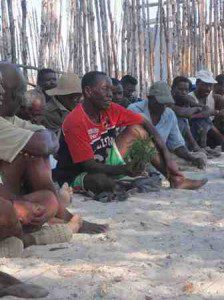By Kame Westerman, Velondriake MPA Project Coordinator. The zebu (cow) lies in the shadow of an expansive tamarind tree, as if resigned to fate – feet tied, breathing deeply, slowly, eyes only half-open. It had been led to this place early, before the sun’s rays coloured the horizon, before the heat could bake the sandy paths. Its imminent sacrifice will mark an important moment in the history of the village – the closure of its first permanent marine reserve.
The village of Tampolove, located in southwest Madagascar, lies within the Velondriake locally managed marine area (LMMA). This LMMA, the first in the nation, encompasses the northern section of the world’s fourth largest reef system and seeks to sustainably conserve this important ecosystem. An important management tool within the LMMA is permanent reserves, which restrict all fishing activities and provide a safe place for fish stocks to proliferate. The village of Tampolove had chosen the placement of the reserve over a year ago, and this is the day that it will be made official, with a traditional ceremony and installation of buoys to demarcate the boundaries.
Once the village members gather, attention turns to an older man in the middle, one of the spiritual elders of the village. Beside him stand a blue plastic jerry can and two large glass bottles filled with clear, pungent moonshine. Someone grabs a handful of hair from the zebu’s tail and places it next to hot coals; smoke from the crackling hair curls high up into the tree branches. The elder, holding a small branch of the tamarind, speaks for a few minutes about the importance of the reserve and asks for the ancestors’ blessing in designating the reserve.
In a country where ancestral connections are still quite strong, receiving acceptance from the ancestors to create a reserve is an important step in achieving community support and long-term protection. In addition to ancestral permission and acquiescence, there is a system of local laws, called a dina, which govern the protected areas. Designed by the communities of Velondriake, enforcement of these laws is wholly their responsibility.
Beside the zebu lies a bright red buoy, ready for its adornment. As the elder finishes his speech, and the moonshine makes its rounds, five young men step towards the zebu. Working as a team, the men are swift and precise in their movements and the sacrifice is soon over. Frothy blood quickly fills two big basins, which are brought over to the buoy. Dipping his hand in the basin, a young man calls out the names of fish while he paints the buoy with blood “varilava…aloalo…geba”. Meanwhile, the zebu is expertly partitioned up, first among villages in the area, then among families. Beef is rare in this part of the country, where arid conditions prevent much cattle production; there will be a veritable feast today.
At last, it is time to place the buoys and a group of community members sail out to the site. As the first anchor is prepared for lowering in, an offering is made to the ancestors. Opening bottles of rum and soda, an appeal is made to ensure the reserve is safe from fishers and, ultimately, to increase harvests in the region. With a quick tip of the bottles into the aqua blue water, the ceremony is completed and the anchor lowered in. Left bobbing at the top is the bright red buoy, painted with blood, representing the hopes of the village and the blessings of the ancestors.


